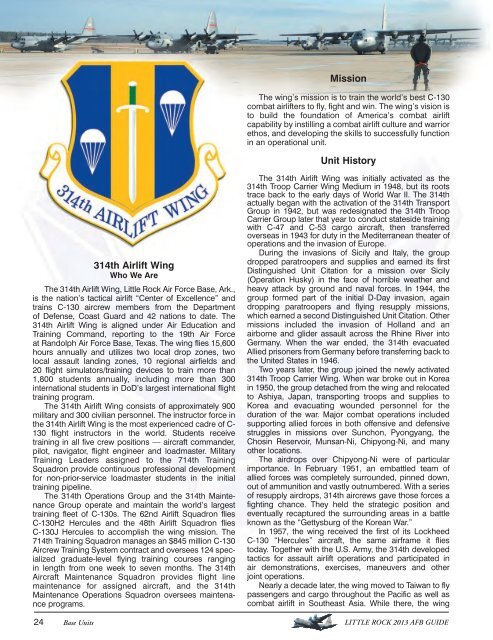Little - Keep Trees
Little - Keep Trees
Little - Keep Trees
Create successful ePaper yourself
Turn your PDF publications into a flip-book with our unique Google optimized e-Paper software.
24 Base Units<br />
314th Airlift Wing<br />
Who We Are<br />
The 314th Airlift Wing, <strong>Little</strong> Rock Air Force Base, Ark.,<br />
is the nation’s tactical airlift “Center of Excellence” and<br />
trains C-130 aircrew members from the Department<br />
of Defense, Coast Guard and 42 nations to date. The<br />
314th Airlift Wing is aligned under Air Education and<br />
Training Command, reporting to the 19th Air Force<br />
at Randolph Air Force Base, Texas. The wing flies 15,600<br />
hours annually and utilizes two local drop zones, two<br />
local assault landing zones, 10 regional airfields and<br />
20 flight simulators/training devices to train more than<br />
1,800 students annually, including more than 300<br />
international students in DoD’s largest international flight<br />
training program.<br />
The 314th Airlift Wing consists of approximately 900<br />
military and 300 civilian personnel. The instructor force in<br />
the 314th Airlift Wing is the most experienced cadre of C-<br />
130 flight instructors in the world. Students receive<br />
training in all five crew positions — aircraft commander,<br />
pilot, navigator, flight engineer and loadmaster. Military<br />
Training Leaders assigned to the 714th Training<br />
Squadron provide continuous professional development<br />
for non-prior-service loadmaster students in the initial<br />
training pipeline.<br />
The 314th Operations Group and the 314th Maintenance<br />
Group operate and maintain the world’s largest<br />
training fleet of C-130s. The 62nd Airlift Squadron flies<br />
C-130H2 Hercules and the 48th Airlift Squadron flies<br />
C-130J Hercules to accomplish the wing mission. The<br />
714th Training Squadron manages an $845 million C-130<br />
Aircrew Training System contract and oversees 124 specialized<br />
graduate-level flying training courses ranging<br />
in length from one week to seven months. The 314th<br />
Aircraft Maintenance Squadron provides flight line<br />
maintenance for assigned aircraft, and the 314th<br />
Maintenance Operations Squadron oversees maintenance<br />
programs.<br />
Mission<br />
The wing’s mission is to train the world’s best C-130<br />
combat airlifters to fly, fight and win. The wing’s vision is<br />
to build the foundation of America’s combat airlift<br />
capability by instilling a combat airlift culture and warrior<br />
ethos, and developing the skills to successfully function<br />
in an operational unit.<br />
Unit History<br />
The 314th Airlift Wing was initially activated as the<br />
314th Troop Carrier Wing Medium in 1948, but its roots<br />
trace back to the early days of World War II. The 314th<br />
actually began with the activation of the 314th Transport<br />
Group in 1942, but was redesignated the 314th Troop<br />
Carrier Group later that year to conduct stateside training<br />
with C-47 and C-53 cargo aircraft, then transferred<br />
overseas in 1943 for duty in the Mediterranean theater of<br />
operations and the invasion of Europe.<br />
During the invasions of Sicily and Italy, the group<br />
dropped paratroopers and supplies and earned its first<br />
Distinguished Unit Citation for a mission over Sicily<br />
(Operation Husky) in the face of horrible weather and<br />
heavy attack by ground and naval forces. In 1944, the<br />
group formed part of the initial D-Day invasion, again<br />
dropping paratroopers and flying resupply missions,<br />
which earned a second Distinguished Unit Citation. Other<br />
missions included the invasion of Holland and an<br />
airborne and glider assault across the Rhine River into<br />
Germany. When the war ended, the 314th evacuated<br />
Allied prisoners from Germany before transferring back to<br />
the United States in 1946.<br />
Two years later, the group joined the newly activated<br />
314th Troop Carrier Wing. When war broke out in Korea<br />
in 1950, the group detached from the wing and relocated<br />
to Ashiya, Japan, transporting troops and supplies to<br />
Korea and evacuating wounded personnel for the<br />
duration of the war. Major combat operations included<br />
supporting allied forces in both offensive and defensive<br />
struggles in missions over Sunchon, Pyongyang, the<br />
Chosin Reservoir, Munsan-Ni, Chipyong-Ni, and many<br />
other locations.<br />
The airdrops over Chipyong-Ni were of particular<br />
importance. In February 1951, an embattled team of<br />
allied forces was completely surrounded, pinned down,<br />
out of ammunition and vastly outnumbered. With a series<br />
of resupply airdrops, 314th aircrews gave those forces a<br />
fighting chance. They held the strategic position and<br />
eventually recaptured the surrounding areas in a battle<br />
known as the “Gettysburg of the Korean War.”<br />
In 1957, the wing received the first of its Lockheed<br />
C-130 “Hercules” aircraft, the same airframe it flies<br />
today. Together with the U.S. Army, the 314th developed<br />
tactics for assault airlift operations and participated in<br />
air demonstrations, exercises, maneuvers and other<br />
joint operations.<br />
Nearly a decade later, the wing moved to Taiwan to fly<br />
passengers and cargo throughout the Pacific as well as<br />
combat airlift in Southeast Asia. While there, the wing<br />
LITTLE ROCK 2013 AFB GUIDE
















